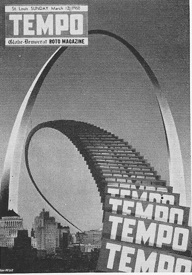Print Articles
The Paper In 1825
We see a copy of the “Missouri Advocate and St. Louis Public Advertiser.” The first two pages are taken up with a verbatim copy of an Address by Henry Clay in Kentucky. He ends his address thus, “That I have often misconceived your true interests is highly probable. That I have sacrificed them to the object of personal aggrandizement I utterly deny. And for the purity of my motives, however in other respects I may be unworthy to approach the Throne of Grace and Mercy, I appeal to the justice of my God with all the confidence which can flow from a consciousness of perfect rectitude.”
On page three the news begins. “With feelings which could only be created by a similar occasion we announce today the arrival of General Lafayette on the steamboat Natchez. Thrice welcome thou Son of Liberty and Companion of Washington to the Home of the Free.”
Here is another news item, “Our readers will see that the Allies have become tired of waiting for the death of King Ferdinand of Spain and have resolved to take out letters of administration and divide the old man’s estate while living. This is a novel proceeding and may be filled with many advantages unknown to the old method of settling affairs.”
Then there is an article urging that St. Louis be made a port of entry. “Seeing no possible objection to the measure, but on the contrary everything urging the adoption of it, we trust that our Government will not hesitate to grant a request so reasonable and necessary to our immediate welfare and prosperity.”
And then, “The Proprietor of the Mansion House Livery Stable respectfully informs the citizens of St. Louis that he is now prepared to accommodate then with Carriages, Barouches, Dearborns, Gigs and Saddle Horses.”
Next follows a “St. Louis Wholesale Prices Current.” Here we read that ham was 5 to 8 cents a pound, corn 18 to 20 cents a bushel, lard 6 to 8 cents a pound and whiskey 25 to 28 cents per gallon.
Then there were quotations of “Exchange.” United States “paper” was from 1 to 2 per cent premium. Drafts on Philadelphia and New York, par. Illinois State Bank, 68 per cent discount. Missouri Loan Office, 25 per cent discount. Commonwealth of Kentucky, 50 percent discount.
“Valuable Real Estate for Sale. The late residence of Col. Elias Rector near the mounds, containing Eight Arpens of Land, situate immediately north of the City of St. Louis. A good dwelling house, barn, stable, carriage house, ice house, garden, and an excellent well of water.”
(From The St. Louis Story by McCune Gill, 1952.)
 The St. Louis Globe-Democrat, beginning on March 12 [1950], will include in its Sunday editions, besides “This Week,” a new type, “local,” color roto magazine to be called “Tempo.” Several reader preference studies have shown that this type of roto magazine section reaches 90% to 95% of the readers of a Sunday newspaper.
The St. Louis Globe-Democrat, beginning on March 12 [1950], will include in its Sunday editions, besides “This Week,” a new type, “local,” color roto magazine to be called “Tempo.” Several reader preference studies have shown that this type of roto magazine section reaches 90% to 95% of the readers of a Sunday newspaper.